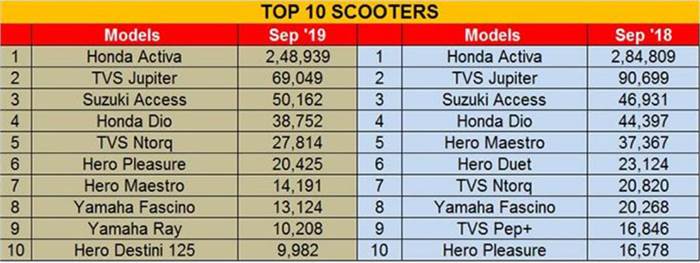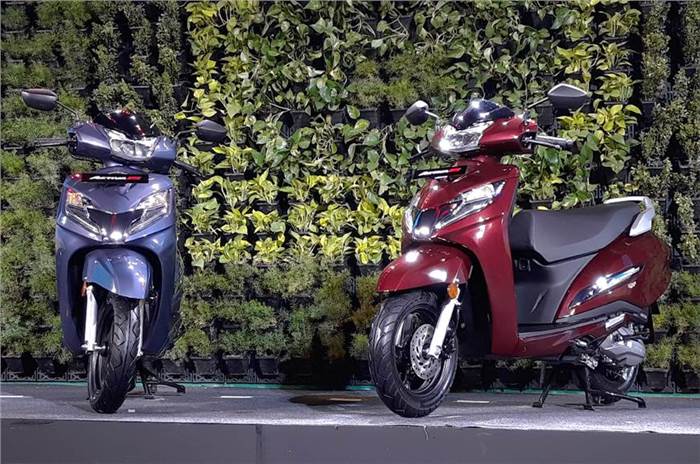Once the darling of the two-wheeler world, the scooter segment has felt the hammer of the economic slowdown, particularly in rural India. In September 2019, total scooter sales fell by 16.60 percent to 5,55,829 units and in the April-September period, overall numbers were down similarly by 17 percent to 31,77,433 units. But there are some products which refuse to be cowed down. Here's looking at them.
The Honda Activa remains the unassailable scooter market leader, though its sales have slowed over the past year. The Activa is India's No. 1 two-wheeler and scooter in September with sales of 2,48,939 units. This performance is better than August’s 2,34,279, July's 2,43,605 or June's 236,739 units, which means month-on-month, Activa numbers are going up, albeit marginally. At the end of May, the company launched the Activa 5G Limited Edition, with prices starting at Rs 55,032 (for the Activa 5G Limited Edition STD) and going up to Rs 56,897 (for the Activa 5G Limited Edition DLX). More recently, in mid-September, Honda launched the BS6 Activa 125 (LINK). India’s first BS6-compliant two-wheeler is available in three variants – Standard, Alloy and Deluxe. The Standard is priced at Rs 67,490, while Alloy and Deluxe cost Rs 70,990 and Rs 74,490, respectively (all prices, ex-showroom Delhi). All three variants are powered by a 124cc engine that develops 8.1hp (a slight drop from the 8.52hp on the outgoing model). However, while the BS6 model uses a carburetted engine, the unit on the new BS6 Activa is fuel-injected.
For the April-September 2019 period, Honda sold a total of 13,93,256 Activas, down a sizeable 22 percent year-on-year [YoY ] (H1 FY2019: 17,86,687), which is also reflected in the scooter segment's H1 sales being down by 16.60 percent YoY, what with the Activa being the market leader.
Jupiter targets Grande effect, Suzuki Access a game-changer
TVS’ bestselling scooter is India's No. 2 scooter – the Jupiter. In an effort to rev up sales, the Chennai-based manufacturer has been busy launching a flurry of variants of its top-selling models, and it looks like the move is working. In September, it launched the new Jupiter Grande, priced at Rs 62,346 (ex-showroom, Delhi). The Bluetooth console-equipped Grande has become the most expensive variant in the range, costing Rs 2,446 more expensive than the Jupiter Grande Disc SBT at Rs 59,900, and Rs 8,855 more than the standard Jupiter. This range-topping variant also comes with call and text notifications, an over-speeding alert and more.
In September the Jupiter sold a total of 69,049 units, contributing to total April-September 2019 sales of 3,52,664 units, down 14 percent on year-ago sales of 4,10,980 units.
The Access is the 125cc scooter that has single-handedly enabled Suzuki to increase its scooter market share to 10.97 percent in H1 FY2020 and contributed to its growth in two-wheeler market share to 3.77 percent. The Access 125 has turned out to be a game-changer for the company. This popular buy – it’s Suzuki's bestselling scooter – is a consistent No. 3 on the sales charts, after the Activa and Jupiter. On July 16, Suzuki launched a refreshed version, the Access 125 Special Edition (SE) that came with a disc brake variant. The scooter is powered by the same all-aluminium, four-stroke, single-cylinder 124cc engine that develops 8.7hp at 7,000rpm and 10.2Nm of torque at 5,000rpm.
In September, the Access 125 went home to 50,162 buyers, up 7 percent (September 2018: 46,931) and was one of the two scooters to have bettered year-ago numbers. The performance is even better on the H1 FY2020 front: 2,99,549 units, up 15 percent YoY (H1 FY2019: 259,872).
The past few months have seen TVS, along with Suzuki Motorcycle India, expand their two-wheeler market share thanks to their scooters' peppy sales.
At No. 4 is the Honda Dio, which saw dispatches of 38,752 units. The Dio has strong brand equity among young college-going buyers, with Jharkhand, Karnataka and Maharashtra being strong markets. Honda Motorcycle & Scooter India (HMSI) is targeting semi-urban and rural India to drive up sales and has tied-up with Cholamandalam Investment & Finance Co for offering retail finance.
The TVS NTorq 125 is turning out to be a standout performer for the company. Compared to a year ago, the 125cc scooter has jumped two ranks to be at the No. 5 spot with 27,814 units sold. It is the only other model, besides the Suzuki Access, to record better sales this year. The snazzy-looking scooter has a lot going for it including its youthful appeal. The scooter is riding the growing wave of demand for 125cc scooters, so expect better numbers to come its way later in the year.
In H1 FY2020, the NTorq has sold 1,40,159 units, which constitutes robust 39 percent YoY growth (H1 FY2019: 1,01,165). Little wonder, in a bid to further accelerate sales, on September 15, TVS launched the NTorq 125 Race Edition at Rs 62,995 (ex-showroom, Delhi). The new model features a new LED headlight with a T-shaped diffused LED DRL, as well as a few other changes – it features a unique colour scheme with the body panels getting a red, black or silver finish and chequered-style decals on the front apron and side panels.
With the addition of the new colour scheme the NTorq is now available in a total of eight colour options, three of which are metallic and five are matte. The scooter is powered by a 124.8cc, single-cylinder engine that makes 9.4hp at 7,500rpm and 10.5Nm of torque at 5,500rpm.
Two Hero MotoCorp scooters take the next two places. The Hero Pleasure with 20,425 units rides it at No. 6. In May 2019, the company rolled out the new Pleasure Plus. Hero is known for its competitive pricing and at Rs 47,300 (drum variant) and Rs 49,700 (disc variant) the manufacturer has corroborated this. It costs just around Rs 2,000 more than the older 100cc Pleasure, that in comparison feels outclassed. The scooter also comfortably undercuts rivals like the Yamaha Fascino (Rs 55,623), Honda Activa-i (Rs 50,974), TVS Scooty Zest (Rs 50,020) and the TVS Wego (Rs 52,162).
Coming up seventh is the Hero Maestro with 14,191 units, sharply down on the 37,367 units it sold a year ago. In May 2019, Hero launched the Maestro Edge 125 in three variants – a carburettor drum brake variant priced at Rs 58,500, a carburettor disc brake variant at Rs 60,000 and a fuel-injected variant at Rs 62,700. These prices are on par with rivals like the TVS NTorq and the Honda Grazia.
At No. 8 is the Yamaha Fascino with 13,124 units, a number which the company knows could be better considering that it had sold 15,479 units in May and 14,873 units in April 2019. Yamaha needs to do more if the current sales momentum is to be maintained, especially when you consider that it now has a direct rival from Hero in form of the new 110cc Pleasure Plus.
The Yamaha Ray takes ninth position with 10,208 units, maintaining its monthly average in a difficult market. This scooter was recently updated with a combined braking system and came with a new blacked-out colour scheme.
The final entry on this Top 10 list is the Hero Destini 125 – its sales have dipped below the 10,000 unit mark in September, with just 9,982 units being dispatched. Five months ago in May, it was at No. 5 on the sales charts and had dropped to No. 6 in June with 11,292 units, a good 5,460 units less than the 16,752 units in May. In April 2019, the Destini 125 had 16,301 units to its name. The aggressive pricing (sub-Rs 55,000 ex-showroom) seems to have worked for a while for the family scooter but consumer preferences are clearly changing.
Over the past decade, gearless scooters have breathed new life to the mobility scenario in the country and have, among other things, enabled women to commute on their own. For a significant amount of time, the scooter segment's growth rate had kept pace with the SUV segment. With the SUV sector bucking the downturn, will scooters follow? Watch this space.




Comments
Member Login
Personal Details
No comments yet. Be the first to comment.